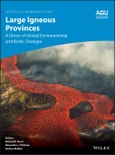This book is Open Access. A digital copy can be downloaded for free from Wiley Online Library.
Exploring the links between Large Igneous Provinces and dramatic environmental impact
An emerging consensus suggests that Large Igneous Provinces (LIPs) and Silicic LIPs (SLIPs) are a significant driver of dramatic global environmental and biological changes, including mass extinctions. Environmental changes caused by LIPs and SLIPs include rapid global warming, global cooling ('Snowball Earth'), oceanic anoxia events, mercury poisoning, atmospheric and oceanic acidification, and sea level changes.
Continued research to characterize the effects of these extremely large and typically short duration igneous events on atmospheric and oceanic chemistry through Earth history can provide lessons for understanding and mitigating modern climate change.
Large Igneous Provinces: A Driver of Global Environmental and Biotic Changes describes the interactions between the effects of LIPs and other drivers of climatic change, the limits of the LIP effect, and the atmospheric and oceanic consequences of LIPs in significant environmental events.
Volume highlights include:
- Temporal record of large igneous provinces (LIPs)
- Environmental impacts of LIP emplacement
- Precambrian, Proterozoic, and Phanerozoic case histories
- Links between geochemical proxies and the LIP record
- Alternative causes for environmental change
- Key parameters related to LIPs and SLIPs for use in environmental change modelling
- Role of LIPs in Permo-Triassic, Triassic-Jurassic, and other mass extinction events
The American Geophysical Union promotes discovery in Earth and space science for the benefit of humanity. Its publications disseminate scientific knowledge and provide resources for researchers, students, and professionals.
Table of Contents
List of Contributors vii
Preface xi
Part I: The Temporal Record of Large Igneous Provinces (LIPs)
1. Large Igneous Province Record Through Time and Implications for Secular Environmental Changes and Geological Time-Scale Boundaries 3
Richard E. Ernst, David P. G. Bond, Shuan-Hong Zhang, Kenneth L. Buchan, Stephen E. Grasby, Nasrrddine Youbi, Hafida El Bilali, Andrey Bekker, and Luc S. Doucet
2. Radiometric Constraints on the Timing, Tempo, and Effects of Large Igneous Province Emplacement 27
Jennifer Kasbohm, Blair Schoene, and Seth Burgess
Part II: Environmental Impacts of LIP Emplacement
3. Global Warming and Mass Extinctions Associated With Large Igneous Province Volcanism 85
David P. G. Bond and Yadong Sun
4. Environmental Effects of Volcanic Volatile Fluxes From Subaerial Large Igneous Provinces 103
Tamsin A. Mather and Anja Schmidt
5. Assessing the Environmental Consequences of the Generation and Alteration of Mafic Volcaniclastic Deposits During Large Igneous Province Emplacement 117
Benjamin Black, Tushar Mittal, Francesca Lingo, Kristina Walowski, and Andres Hernandez
6. Environmental Impact of Silicic Magmatism in Large Igneous Province Events 133
Scott E. Bryan
7. Evaluating the Relationship Between the Area and Latitude of Large Igneous Provinces and Earth's Long-Term Climate State 153
Yuem Park, Nicholas L. Swanson-Hysell, Lorraine E. Lisiecki, and Francis A. Macdonald
8. Preliminary Appraisal of a Correlation Between Glaciations and Large Igneous Provinces Over the Past 720 Million Years 169
Nasrrddine Youbi, Richard E. Ernst, Ross N. Mitchell, Moulay A. Boumehdi, Warda El Moume, Abdelhak Ait Lahna, Mohamed K. Bensalah, Ulf Soderlund, Miguel Doblas, and Colombo C. G.Tassinari
9. Phanerozoic Large Igneous Province, Petroleum System, and Source Rock Links 191
Steven C. Bergman, James S. Eldrett, and Daniel Minisini
Part III: Geochemical Proxies for the Environmental Effects of LIPs
10. The Osmium Isotope Signature of Phanerozoic Large Igneous Provinces 231
Alexander J. Dickson, Anthony S. Cohen, and Marc Davies
11. Sedimentary Mercury Enrichments as a Tracer of Large Igneous Province Volcanism 247
Lawrence M. E. Percival, Bridget A. Bergquist, Tamsin A. Mather, and Hamed Sanei
12. Platinum Group Element Traces of CAMP Volcanism Associated With Low-Latitude Environmental and Biological Disruptions 263
Jessica H. Whiteside, Paul E. Olsen, Sean T. Kinney, and Mohammed Et-Touhami
13. Assessing the Effect of Large Igneous Provinces on Global Oceanic Redox Conditions Using Non-traditional Metal Isotopes (Molybdenum, Uranium, Thallium) 305
Brian Kendall, Morten B. Andersen, and Jeremy D. Owens
14. Marine Anoxia and Ocean Acidification During the End-Permian Extinction: An Integrated View From Delta238U and Delta44/40Ca Proxies and Earth System Modeling 325
Ying Cui, Feifei Zhang, Jiuyuan Wang, Shijun Jiang, and Shuzhong Shen
15. Trends in Ocean S-Isotopes May Be Influenced by Major LIP Events 341
Ross. R. Large, Jeffrey A. Steadman, Indrani Mukherjee, Ross Corkrey, Patrick Sack, and Trevor R. Ireland
16. Marcasite at the Permian-Triassic Transition: A Potential Indicator of Hydrosphere Acidification 377
Elena Lounejeva, Jeffrey A. Steadman, Thomas Rodemann, Ross R. Large, Leonid Danyushevsky, Daniel Mantle, Kliti Grice, and Thomas J. Algeo
Part IV: Phanerozoic and Proterozoic Case Histories
17. The Monterey Event and the Paleocene-Eocene Thermal Maximum: Two Contrasting Oceanic Carbonate System Responses to LIP Emplacement and Eruption 403
Tali L. Babila and Gavin L. Foster
18. Permian Large Igneous Provinces and Their Paleoenvironmental Effects 417
Jun Chen and Yi-Gang Xu
19. Was the Kalkarindji Continental Flood Basalt Province a Driver of Environmental Change at the Dawn of the Phanerozoic? 435
Peter E. Marshall, Luke E. Faggetter, and Mike Widdowson
20. Large Igneous Provinces (LIPs) and Anoxia Events in "The Boring Billion" 449
Shuan-Hong Zhang, Richard E. Ernst, Jun-Ling Pei, Yue Zhao, and Guo-Hui Hu
21. Breaking the Boring Billion: A Case for Solid-Earth Processes as Drivers of System-Scale Environmental Variability During the Mid-Proterozoic 487
Charles W. Diamond, Richard E. Ernst, Shuan-Hong Zhang, and Timothy W. Lyons
Index 503








